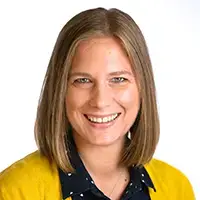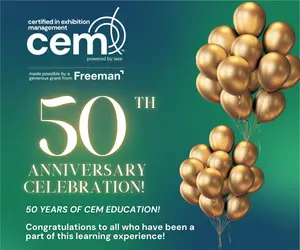By Jennifer Potter, CEM | Senior CEM Program Manager | IAEE

Robyn Davis, CPTD, CEM is a Trade Show Strategy Specialist and Owner of Exhibitors WINH (When I Need Help) LLC. She works with event organizers as a speaker, trainer and consultant to help them help their exhibitors squeeze even more value out of each event. Here, she talks with IAEE Senior CEM Program Manager Jennifer Potter, CEM about being a faculty member of IAEE’s CEM Learning Program.
What made you want to become a CEM faculty member?
There are a number of reasons I wanted to become a CEM faculty member (see video on LinkedIn here), but probably the most important is that it aligns nicely with one of my favorite parts of working in the trade show industry: seeing the “ripples” our efforts produce.
For example, when I’m advising a startup on how to exhibit effectively one year, that often helps them grow into a larger company (with more staff and a larger booth) the next year. Through my own work, I’ve had the privilege of seeing these efforts “ripple” from the exhibitors through their companies and into their communities; plus, because I’ve been helping exhibitors through their organizers for quite some time now, I’m even starting to see some greater impacts on their trade shows and industries overall!
Now, as a CEM faculty member, I’ll get to help the professionals who help the exhibitors. Together, I expect that we’ll be able to make an even bigger “ripple effect” and have an even bigger impact on the entire world around us… not just the companies and communities or events and industries… if not today, some day (ideally, soon).
How do you prepare for your CEM courses?
Although IAEE offers a number of templates and sample materials to help faculty members streamline their course preparations, I prefer to start my planning process from scratch.
First, I re-read the course description and the workbook (along with any evaluation feedback, when available), as this ensures I’m clear on the participants’ expectations and that I can address them appropriately. Next, armed with stacks of colored sticky notes, I go back through the workbook a handful of times, looking for appropriate opportunities for interaction (and special activity or exercise ideas), key terms and/or formulas that may be important, tricky sections that are likely to require more through explanation or practice, and a few other important elements too.
Then, that’s when the real work (of mapping out our agenda strategically, creating a slide deck that adds real value, choosing the right tools and technology for all of our activities, etc.) begins!
All in, preparing to facilitate a CEM course takes me days or weeks rather than just hours – it’s definitely not something I could do on the plane ride to our venue; but, for me, it’s worth it to ensure every participant who wants to learn has the best possible chance to do so.
If not the templates and sample materials provided by IAEE, are there any other resources you do reference when preparing to facilitate CEM courses?
Absolutely!
But first, I should have said before that the one resource I always pull from IAEE directly is their sample exam questions.
As faculty, I’m not allowed to know what questions will be asked on the exam, but I do remember (from my own experience in pursuing my CEM) that the real questions tend to feel a lot like the samples provided. So, I incorporate those questions into mini-knowledge checks throughout the day, in order to give more confidence to those who will be testing at the end.
Otherwise, before earning my CEM, I also earned a certification in talent development (CPTD), which requires me to prove I understand adult learning science/best practices and to keep up to date on the latest trends in the field of talent development. As I study these topics to maintain my certification (not to mention support my day-to-day work), I also take away ideas I can apply to the CEM courses I facilitate.
Then, there are some related topics, like neuroscience, that I study for fun because I find it fascinating. I look for ways to incorporate those principles into my courses too. For example, neuroscience is especially useful when I’m mapping out the agenda for each course; shifting the most complicated “heavy thinking” material earlier and saving more of our “lighter” more creative group work until after lunch is just one way I can make it easier for my participants to remain engaged all day and absorb more of the information shared.
Finally, I lean on my industry connections, as needed, to better understand the different applications of the CEM coursework. Talking to a variety of organizers, industry partners, and our shared audience members (exhibitors, sponsors, attendees, and others) gives me extra “real world” insights that often resonate well with the participants, beyond what I’d find in the workbook or even my own personal experience.
What do you think your biggest strength is as a faculty member?
Aside from my experience in talent development and how seriously I take my responsibility as a faculty member, I think one of the biggest strengths I bring to this role is my fresh perspective.
I’ve been in this industry for over 14 years, but not in a traditional “exhibition organizer” or typical “supplier partner” (service contractor, venue, etc.) role – instead, I think of myself as the bridge between exhibitors and organizers, which gives me a closer look at both sides of the aisle than most professionals get to experience.
Ultimately, I tend to see things differently than most and, as a result, I can often help our learners see things differently than they normally would as well.
How did you get started in training? Tell me more about your progression and accomplishments.
That’s kind of a long story, but basically…
When I started my business, I was working with individual exhibitors in their booths; so, the natural next step to helping those same exhibitors more was to expand my offerings to include training and consulting services.
Then, as I was looking for opportunities to scale my business, I started working with organizers to create and facilitate custom exhibitor success programs (that way, instead of helping just one exhibitor at a time, I was helping all of the exhibitors… making a bigger impact through my training, consulting, and other services without as much paperwork behind the scenes).
Around the same time, I also started doing more speaking and training at industry events (like ExhibitorLive, IMEX America, and Expo! Expo!), through my own programs (like Trade Show Summer School), and even won some related awards (like the EIC’s Pacesetter Award and, more recently, IAEE’s Educator of the Year Award).
In 2019, I decided to pursue “the pinnacle of achievement in talent development” (earning my first certification and becoming a Certified Professional in Talent Development) and, because I’ve been phasing out my direct-to-exhibitor services, I followed my CPTD with my CEM, which has helped me to get to know the organizer side of the industry even better (since I was already very familiar with the exhibitor side).
Speaking of organizers, I’m proud to say that my clients have won some impressive awards for our exhibitor success programming too (e.g. RSNA’s “Best New Idea” Award from TSE and the SHOT Show’s “Exhibitor Excellence” Award from TSNN, to name a few)!
Overall, training has been a major part of my business from pretty close to the beginning. Facilitating CEM courses feels like just as natural of a progression to expand upon my work with organizers (in support of their exhibitors), as my transition from working with exhibitors (in their booths) to adding in training and consulting services had been before.
What has been your favorite part of your CEM journey and, specifically, joining the CEM faculty?
For me, it’s definitely the community.
When I started my CEM, I wasn’t quite sure what to expect, so I reached out to industry professionals who had CEM in their name on LinkedIn for advice. I have to say – the responses I received to those short messages were so thoughtful. Almost everyone replied quickly and with something encouraging to say!
Then, as I worked through my classes and into the CEM faculty application process, I made great friends fast. Even in my first CEM faculty training and welcome reception (technically, before I was officially a part of the faculty), I felt very welcome, both by the IAEE staff and my peers.
One more example: since becoming an official CEM faculty member, I’ve had the opportunity to recommend venues for the in-person classes I’ll facilitate in the future. Even though I don’t have any suitable office space of my own to share, I do have a number of very generous connections. Almost immediately after posting about this on LinkedIn, we were able to secure two new, convenient spaces and, as a result, add two more CEM courses to the schedule for everyone to enjoy.
I look forward to building upon those relationships and, also, finding opportunities to pay that kindness forward to others for however long I’m a part of this group (and beyond).
How do you think you can improve the CEM Learning Program?
I hope it’s okay to share (since I’m not sure if we will have announced this to the CEM faculty members by the time this interview is published – spoiler alert!), but I was recently invited to speak to the CEM faculty, in a meeting later this year, and share some tips for making CEM courses more “adult learner friendly.”
Understanding that most faculty members don’t have a lot of formal training in training (totally understandable!), my goal is to highlight simple, attainable ways that they can tweak their typical approach to better suit modern learners. Everyone has their own style, which is great, but I think there’s a lot of little things we can do, as a group and on our own, to make these courses more helpful and engaging for those who participate, on a more consistent basis.
Anything else you’d like to say?
Thank you for inviting me to chat – it’s been a pleasure!
I think the CEM program is already great and my goal, as a new faculty member, is to help in making it even better for future CEM candidates and credential holders.
Learn more about the CEM Learning Program here!
About the Author

Jennifer Potter, CEM is the Senior CEM Program Manager for IAEE. She has been in the industry for 20 years, 14 of those with IAEE. Jennifer manages all aspects of the CEM Learning Program.


